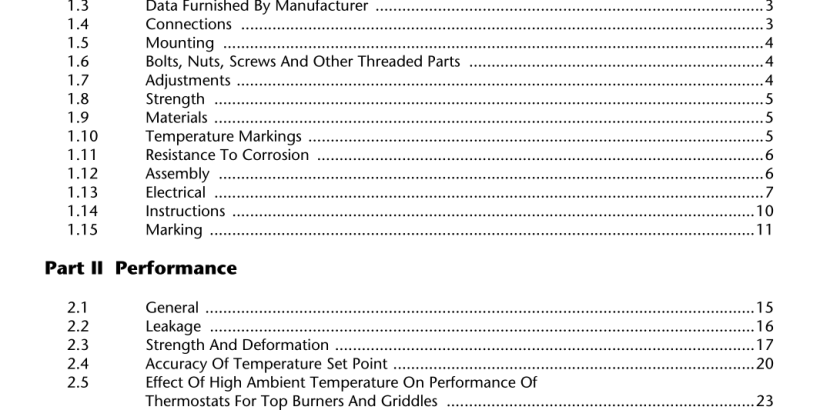CSA ANSI Z21.23-2010 pdf download.American National Standard For Gas Appliance Thermostats
1.13.8 Spacings
a. The electrical clearance resulting from the assembly of line-voltage parts into the complete component, except for thermo-electric circuits, shall comply with the spacings specified in Table IV, Minimum Spacings Line Voltage Circuits for Safety Circuits. Film-insulated wire is considered to be equivalent to an uninsulated live-metal part in determining compliance of device with the spacing specification in this standard.
b. For parts connected to Class 2 low-voltage circuits and millivoltage circuits intended for access after the control in manufactured (e.g., field- or factory-wired terminals), the spacings shall not be less than those indicated in Table V, Minimum Spacings – Millivoltage Circuits Intended for Access After the Control Manufacturer and for Class 2 Low Voltage Safety Circuits (0-30 Volts), if a short circuit or ground between those parts could result in unsafe operation. For millivoltage circuits not intended for access after the device is manufactured, if shorting of the circuit can result in unsafe operation, the construction of the device shall be such that the spacings are permanently maintained.
c. For parts connected to an isolated limited secondary circuit (other than Class 2), the spacings shall not be less than those indicated in Table VI, Minimum Spacings – Isolated Limited Secondary Circuits for Safety Controls, if a short circuit or ground between those parts could result in unsafe operation. For an isolated-limited-secondary circuit, other than safety circuit, the spacings between uninsulated live parts of opposite polarity and between uninsulated live parts and dead metal that may be grounded in service are not specified. The minimum spacings are based on acceptable performance of specified dielectric voltage withstand and other normal and abnormal operation tests.
1.13.9 Barriers
a. With the following exceptions, an insulating barrier or liner which is used to provide spacings shall be of material suitable for the particular application and not less than a minimum 0.028 in (0.71 mm) thick. A barrier or liner which is used in conjunction with not less than 1 / 2 the specified spacing through-air, may be less than 0.028 in (0.71 mm) but not less than 0.01 3 in (0.33 mm) thick, provided the barrier or liner is (1 ) of good quality of suitable insulating material resistant to moisture; (2) capable of adequate mechanical strength if exposed or otherwise likely to be subjected to mechanical injury; (3) reliably held in place; and (4) located so it will not be adversely affected by operation of the equipment in service-particularly arcing.
Insulating material having a thickness less than that specified in the preceding paragraph may be used if found acceptable for the purpose or if listed or certified for the purpose by a nationally recognized testing agency. Mica may be less than 0.028 in (0.71 mm) thick but not less than 0.01 3 in (0.33 mm) thick when the mica is used in lieu of the throughair spacing specified in Table IV, Minimum Spacings-Line Voltage Circuits for Safety Circuits, provided the mica is tightly held in a fixed position by the parts between which the spacing is involved.
b. A barrier used to provide separation between the wiring of different circuits shall have adequate mechanical strength and shall be reliably held in place. A barrier between uninsulated live-metal parts connected to different circuits, and a barrier between uninsulated live-metal parts of one circuit and the wiring of another circuit shall also comply with 1 .1 3.9a. Openings in a barrier for the passage of conductors shall not be larger than 1 / 4 in (6.4 mm) in diameter and shall not exceed in number, the number of wires which pass through the barrier.CSA ANSI Z21.23-2010 pdf download
